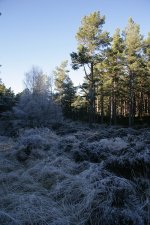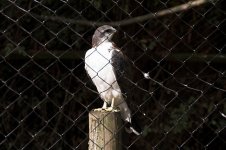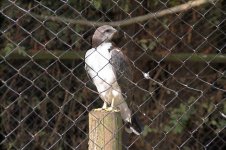nigelblake
don't re member
Multiple RAW conversion for high dynamic range
There are circumstances when the contrast in a scene would seem too much to enable you get an image that resembles what you see with the eye, and also there are issues with changes in colour temperature throughout the scene as well.
One of the advantages of shooting RAW is the control that you have over the resulting image during processing, with jpegs you are stuck with the stripped down data that remains after the in-camera processing, so any adjustment you make in Photoshop etc will usually have a noise penalty.
Here are two images, the first is the scene straight from the camera, as you will see the underexposed forground, which is in shadow, also has a strong blue colour cast, the second image is a composite of 4 conversions of the same RAW file, each conversion having different amounts of adjustment to exposure, contrast and colour temperature, the accurately corrected elements of each image then make up the final picture. In this example I manually composited the various elements using layers, but there are high dynamic range (HDR) software available that will do this automatically, see details on picture link below.
Other than just several conversions of the same image file you can also shoot different bracketed exposures and get even greater dynamic range, an example here http://www.birdforum.net/pp_gallery/showphoto.php/photo/103783/sort/1/cat/500/page/3
of course these would need to be done on a locked-off tripod to ensure alignment in the final composite image although some of the HDR software will align images automatically.
If shooting several bracketed images it is also possible to increase DOF at the same time by using focus stacking, i.e focusing on distant, midrange and foreground on the separate shots so that when composited you have front to rear sharpness too.
This technique (multiple conversion of the same RAW file) will work very well on high contrast birds too, things like magpies and woodpeckers that are Black and white where there is a risk of blown whites being a good example.
There are circumstances when the contrast in a scene would seem too much to enable you get an image that resembles what you see with the eye, and also there are issues with changes in colour temperature throughout the scene as well.
One of the advantages of shooting RAW is the control that you have over the resulting image during processing, with jpegs you are stuck with the stripped down data that remains after the in-camera processing, so any adjustment you make in Photoshop etc will usually have a noise penalty.
Here are two images, the first is the scene straight from the camera, as you will see the underexposed forground, which is in shadow, also has a strong blue colour cast, the second image is a composite of 4 conversions of the same RAW file, each conversion having different amounts of adjustment to exposure, contrast and colour temperature, the accurately corrected elements of each image then make up the final picture. In this example I manually composited the various elements using layers, but there are high dynamic range (HDR) software available that will do this automatically, see details on picture link below.
Other than just several conversions of the same image file you can also shoot different bracketed exposures and get even greater dynamic range, an example here http://www.birdforum.net/pp_gallery/showphoto.php/photo/103783/sort/1/cat/500/page/3
of course these would need to be done on a locked-off tripod to ensure alignment in the final composite image although some of the HDR software will align images automatically.
If shooting several bracketed images it is also possible to increase DOF at the same time by using focus stacking, i.e focusing on distant, midrange and foreground on the separate shots so that when composited you have front to rear sharpness too.
This technique (multiple conversion of the same RAW file) will work very well on high contrast birds too, things like magpies and woodpeckers that are Black and white where there is a risk of blown whites being a good example.
Attachments
Last edited:







